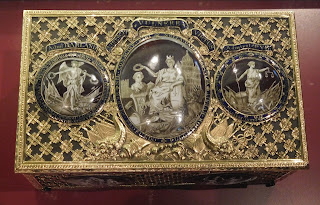Susan reporting,
Wars are fought by armies, soldiers, and generals, but too often civilians in the path of battles suffer, too.
Earlier this year I wrote about
Gideon Gilpin, a Quaker farmer and his young family living near present-day Chadds Ford, PA. In 1777, the Gilpins found themselves in the middle of the Battle of Brandywine, the largest land battle (in number of men) of the American Revolutionary war. As a Friend, Gilpin followed his religious beliefs and refused to choose one side over the other in the conflict, and was distrusted by both the British and Continental Armies. When the battle was done, his farm was destroyed because of his pacifism, and he'd lost all his crops and his livestock as well.
The Gilpin family's nearest neighbors, also Friends, made a different choice. Benjamin Ring was far more prosperous and established than Gideon Gilpin. Not only did he own a 150-acre farm, but also three mills: a fulling mill (for woolen cloth), a tannery, and a sawmill. The Rings' house was nearly double the size of the Gilpin's home, and more elegant, too, with more and larger rooms and handsome woodwork. The Ring family had six children, and the household also included two indentured servants.

But when the Revolution began, Benjamin Ring decided to go against his beliefs as a Friend, and side with the Continental forces. Both he and his two older sons were on the local militia rolls, meaning that they were willing to bear arms. For this, Ring and his sons were read out of their Meeting (banished from their Quaker congregation). When Commander-in-Chief General George Washington and his officers came to reconnoiter the area near the Ring farm in anticipation of a major battle, Ring welcomed them into his home, offered them hospitality, and supplied them with information. Soon after, in early September, 1777, Washington returned with his army, determined to stop General Sir William Howe from taking Philadelphia. The Continental forces numbered about 11,000 men, facing approximately 15,000 British and Hessian soldiers.
The Ring house became the general's headquarters, and Mrs. Ring's parlor was the army's central office and the site of terse Councils of War. The
general's tent was pitched behind the house, and the rest of the army camped nearby. (Among the youngest of the officers: Lieutenant Colonel Alexander Hamilton, and the Marquis de Lafayette, recently commissioned as a major general.) For two days and nights, Mrs. Ring cooked for the general and his officers; the receipt (this is a copy,
above right) for the payment for the six meals for thirty men still exists. On the morning of September 11, 1777, the day-long battle began.
While Mr. Ring and his older sons were with Washington's troops (and eventually advised the general on the best path for the army's retreat), Mrs. Ring and the younger children remained at the house. As the fighting drew closer, she decided to flee to the safety with her children, loading boxes of valuables and gold into a carriage. But she'd waited too long, and the road was now blocked with soldiers. Abandoning their carriage and belongings, they fled on foot across the fields to the relative safety of the nearby meetinghouse.
Meanwhile, fighting surrounded their now-empty house. The kitchen gardens were rutted and churned, stone walls were pitted by shot, and a cannonball left its mark on one of the gables. But more indignity followed after the Americans retreated, and the British claimed victory. The Ring property was singled out as the home of a traitor who'd supported the rebels. Everything inside it was either stolen or wantonly destroyed. All the farm's livestock was taken or slaughtered, and the orchards and surrounding fields of crops were burned. The contents of the three Ring mills were also destroyed and made unusable.
When the British finally left after three days and the Ring family returned, only the shell of their house remained. The Rings applied to Congress to be compensated for their losses, and were paid in near-worthless Continental bills. More heartbreaking sorrow came when their youngest daughter sickened and died from an illness left by the armies.
Yet Ring family tradition states that Benjamin Ring claimed to have no regrets about having aided Washington and the Continental cause. Standing in the ruins of her home with a dying child, I wonder if Mrs. Ring felt the same.
After the Battle of Brandywine, the house was repaired, and over time served as a tavern, hotel, and tenant farmer's housing. In the early 20thc, it became a tourist attraction as Washington's headquarters, operated by historian, teacher, and preservationist Christian C. Sanderson. In 1931, the house suffered a devastating fire, and fell into overgrown ruins. Eighteen years later, the State of Pennsylvania purchased the property, and rebuilt the house to reflect its appearance in 1777. It is now open to visitors as part of
Brandywine Battlefield Park, which this fall will be the center of a
major reenactment of the battle.
Coming next week: A first-person recollection by one of the Rings' younger sons who watched the battle - and the destruction of his home - from the branches of a nearby peach tree.
Many thanks to Andrew Outten, director of education & museum services at Brandywine Battlefield Park, for his excellent tour and additional information for this post.
Photos ©2017 by Susan Holloway Scott.















































 One of us --
One of us -- 


